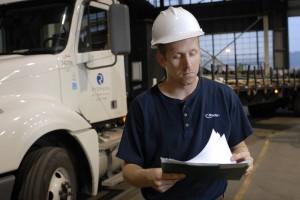Don’t let safety issues derail your transportation and distribution network. Make safety an inside job.
When it comes to getting products from one location to another, safety issues can derail even the highest-performing transportation network. Last year alone, large trucks and commercial vehicles were involved in some 500,000 crashes.
The human impact of truck-related accidents can be deadly. So can the financial impact. Just one major accident can affect your reputation and your business success for years to come. Especially when you consider that the average cost of a major accident involving a tractor/trailer is more than $7.6 million according to the Federal Motor Carrier Safety Administration (FMCSA).
Just offsetting the cost of a $25,000 crash (including cargo and vehicle damage, medical and injury costs) takes an additional $1.25 million in revenues. And that’s just the tip of the iceberg. These figures don’t account for additional cost factors like damaged goods, missed customer commitments, vehicle downtime and replacement or administrative costs.

Here are five ways you can make safety an inside job:
- Build a safety-driven culture: Want to reduce crashes, fatalities and insurance claims? Start by fostering a safety-driven culture. A company-wide focus on safety doesn’t just improve worker productivity and morale, and position your business and your brand as socially responsible. It helps protect your company’s physical assets, personnel and intellectual property, while saving thousands, if not hundreds of thousands, of dollars.
- Put a safety program in place: Assess your current safety practices and identify areas for improvement. Get a safety program in place to provide a foundation for more far-reaching efforts. Identify an executive champion to signal the importance of the initiative to everyone in the enterprise. Designate a safety manager to lead the program. Engage employees by communicating safety messages, making sure policies, safety responsibility and messages are clear and simple. Set up processes for hiring, training and monitoring drivers and be sure to track results and recognize/reward drivers for safe behaviors.
- Stay ahead of problems with preventive maintenance: Standard inspections, preventive maintenance at regular intervals and inspections at fuel stops can help you prevent defects and failures and manage breakdowns. The top reasons for breakdowns include tires, electrical systems, brake issues and running out of fuel. Regularly scheduled preventive maintenance can head off many of these problems before they create emergencies.
- Get connected with advanced technology: Explore safety-enhancing technologies like telematics, which not only help reduce the number of accidents and costs associated with loss, vehicles out of service and liability, but also monitor fuel consumption, idle time, truck location and other vital statistics. By combining an onboard computer with wireless communications and GPS, telematics transforms ordinary trucks into connected vehicles that give you visibility into your vehicles and drivers when they’re on the road.
- Do what it takes to improve compliance: Tough new CSA requirements hold companies accountable for the actions of their drivers. What’s more, the government has made compliance a priority and is enforcing policies with stronger penalties. Take steps to minimize violations that can result in costly fines and downtime. Keep your trucks, drivers and company compliant with ongoing driver training and proper licensing, permitting, load securement and maintenance.
Don’t have the resources on-hand to establish a safety-driven culture, hire and train qualified drivers, keep your fleet maintained for peak performance or comply with tough new regulations? Consider partnering with a logistics and transportation partner with a proven safety record and programs, teams and infrastructure already in place.
Are you taking steps to establish a culture of safety at your company? What have you found to be the most effective initiatives?
Let us know. You can comment and ask questions below.
Written by Jorge Salas, Vice President of Ryder Dedicated (West)
Jorge Salas is Vice President of Ryder Dedicated Operations (West) for Ryder System, Inc. Mr. Salas is responsible for managing a portfolio of more than 70 customers across multiple industries including the newspaper, food and beverage, retail, and building materials markets in the Western United States.

